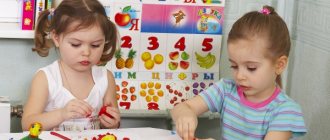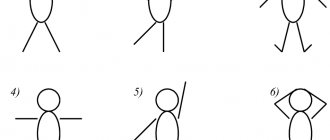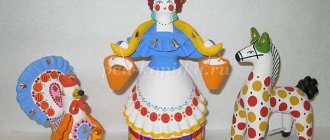Lesson notes on decorative drawing
In the preparatory group, standard long-term planning provides for one drawing lesson per week. The total duration of continuous activity should not exceed 20–25 minutes; methodological manuals recommend performing physical exercises (finger, breathing, motor exercises) for 5 minutes for relaxation and prevention of mental and physical fatigue in children.
Organizational part of the lesson
Lesson outline:
- Organizational part (3–5 minutes). The practical part of the lesson can be preceded not only by reading fairy tales, poems or riddles, but also by watching educational pictures, presentations, a fragment of an educational film or cartoon. The information and familiarization stage involves awakening children's interest in the task and becoming familiar with the elements of painting for decorating objects. It is necessary to include surprise moments, elements of theatrical or didactic games that stimulate creative activity and create a psychologically comfortable environment.
- Practical part - the teacher explains the essence of the task (3-5 minutes). Older preschoolers are given more freedom in the drawing process; showing a sample prepared by the teacher is used less and less for sketching, more often to demonstrate new techniques or clarify the sequence of work. Techniques that have already been mastered do not require additional demonstration.
- Independent work of children (15–20 minutes). The teacher prompts and helps if children have difficulties or misunderstandings while drawing.
- The final part is the analysis and assessment by children of their works and the drawings of their comrades. Children are taught to formulate their point of view with reason and verbally express the aesthetic perception of creative works (3-5 minutes).
Lesson summary on the topic “Blue Gzhel” (author E. Ulimova)
| Goal of the work: introducing older preschoolers to the basics of arts and crafts Equipment:
Items of decorative and applied art (Zhostovo trays, Palekh boxes, Filimonov whistles, Khokhloma dishes, nesting dolls (Semyonov, etc.), an exhibition of Gzhel dishes and dolls in “Gzhel” costumes (At the beginning of the lesson, it is covered with blue and white chiffon), Cut-out pictures for the didactic game “Assemble the picture and guess the painting”, Drawing of Gzhel dishes, painted over with white paint so that blue patterns appear, contour blanks of Gzhel dishes, blue gouache, brushes No. 1 and 2. 1. Organizational part. Educator. Guys, today we with you we will take a journey into the world of beauty, goodness, into the world of amazing creations of folk craftsmen. And for this we must smile at each other and say hello. Hello, golden sun! Hello, blue sky! Hello, light breeze! Hello, little leaf! We live in my native land. I greet you all! (Children repeat the movements after the teacher) Educator. Folk art has its roots in ancient times. The people have always had a need to decorate their life, the things that constantly surrounded them. What did folk artists paint? (Children list the objects lying on the table) All these beautiful and useful things were made by folk craftsmen with their own hands. They gave us and all the people a real holiday. They believe that all these things are not only necessary in everyday life, but also decorate our lives. Please come here. Here are the pieces of the mosaic. Put the pieces together to create a whole picture and see what you come up with. Didactic game “Collect the picture and guess the painting” Conversation during the game. What's in your picture? What kind of painting is this? What elements of Gorodets painting can be seen in this picture? What kind of dishes were painted in Gorodets? How do Filimonov toys differ from all others? What patterns were drawn on Filimonov whistles? In what village were such beautiful toys made? What elements make up Dymkovo patterns? And I have prepared a very beautiful painting for you. Look at the magical blue Gzhel patterns on her. Oh, what is this, I don’t understand anything? Who did this? He painted over all the blue patterns, as if he had frozen them...... Teacher. Gee. Winter covered blue Gzhel with snow. (we approach the tables). And our dishes, which we painted yesterday, were covered with snowflakes and no patterns were visible. There’s not even anything to surprise moms and dads with. We will have to work hard again, to return the patterns to the dishes. Maybe then Gzhel will return to us. 2. Practical part. I think that this will not be difficult for you to do, because you are real craftsmen, masters of your craft. First, let's remember what the painting is called, the elements of which we used yesterday when painting dishes? (Gzhel painting) What paint do we need? What brush techniques did you use when painting? (Drawing with the whole brush, the tip of the brush, dabbing, smearing) 3. Independent work of children. Educator. Now sit back and get to work. Don't rush, remember the proverbs that the Russian people came up with about those who are in a hurry. (If you hurry, you will make people laugh. If you do it quickly, you will redo it.) 4. The final part. Bring your finished works to the exhibition. Analysis of works.
|
Examples of finished works
Children put their finished work on the table so that the teacher can evaluate their talent. Most often, children like to draw images on the theme “Defender of the Fatherland Day”, “March 8”, “Autumn”, “Spring has come”, “The coldest month”, “Profession”, “Forest”, “Why day follows night”, “Clothing” ", "Our kindergarten is like a home."
Works of preschoolers
The most popular theme for children is “Headdress”. The children learn to correctly name hats and their parts, telling what types they come in. For example, to come to the beach, you need to wear a Panama hat and a hat. When late autumn comes, women wear scarves and light scarves. And already in February and January you need to wear a warm pompom.
Drawing lesson on the theme “Maslenitsa” in the 2nd junior group of a preschool educational institution





